radar MITSUBISHI ECLIPSE CROSS 2020 Owner's Manual (in English)
[x] Cancel search | Manufacturer: MITSUBISHI, Model Year: 2020, Model line: ECLIPSE CROSS, Model: MITSUBISHI ECLIPSE CROSS 2020Pages: 427, PDF Size: 78.05 MB
Page 178 of 427
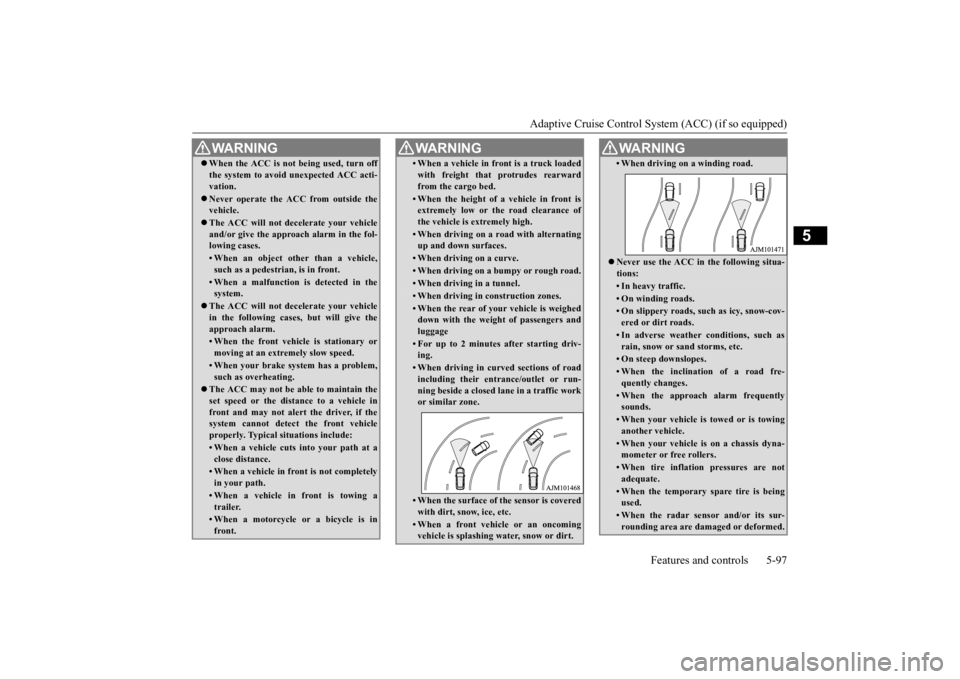
Adaptive Cruise Control System (ACC) (if so equipped)
Features and controls 5-97
5
WA R N I N G When the ACC is not being used, turn off the system to avoid unexpected ACC acti- vation. Never operate the ACC from outside the vehicle. The ACC will not decelerate your vehicle and/or give the approach alarm in the fol- lowing cases.• When an object other than a vehicle,such as a pedestrian, is in front. • When a malfunction is detected in thesystem.
The ACC will not decelerate your vehicle in the following cases, but will give the approach alarm.• When the front vehicle is stationary ormoving at an extremely slow speed.• When your brake system has a problem,such as overheating.
The ACC may not be able to maintain the set speed or the distance to a vehicle infront and may not alert the driver, if the system cannot detect the front vehicle properly. Typical situations include: • When a vehicle cuts into your path at aclose distance.• When a vehicle in front is not completelyin your path.• When a vehicle in front is towing atrailer.• When a motorcycle or a bicycle is infront.
• When a vehicle in front is a truck loaded with freight that protrudes rearward from the cargo bed.• When the height of a vehicle in front isextremely low or the road clearance of the vehicle is extremely high.• When driving on a road with alternatingup and down surfaces.• When driving on a curve.• When driving on a bumpy or rough road.• When driving in a tunnel.• When driving in construction zones.• When the rear of your vehicle is weighed down with the weight of passengers and luggage• For up to 2 minutes after starting driv-ing.• When driving in curved sections of roadincluding their entrance/outlet or run- ning beside a closed lane in a traffic workor similar zone.• When the surface of the sensor is coveredwith dirt, snow, ice, etc.• When a front vehicle or an oncomingvehicle is splashing water, snow or dirt. WA R N I N G
• When driving on a winding road. Never use the ACC in the following situa- tions:• In heavy traffic.• On winding roads.• On slippery roads, such as icy, snow-cov- ered or dirt roads.• In adverse weather conditions, such asrain, snow or sand storms, etc.• On steep downslopes.• When the inclination of a road fre- quently changes.• When the approach alarm frequentlysounds.• When your vehicle is towed or is towinganother vehicle.• When your vehicle is on a chassis dyna-mometer or free rollers.• When tire inflation pressures are notadequate.• When the temporary spare tire is beingused.• When the radar sensor and/or its sur-rounding area are damaged or deformed.WA R N I N G
BK0277700US.bo
ok 97 ページ 2019年3月8日 金曜日 午前9時23分
Page 179 of 427
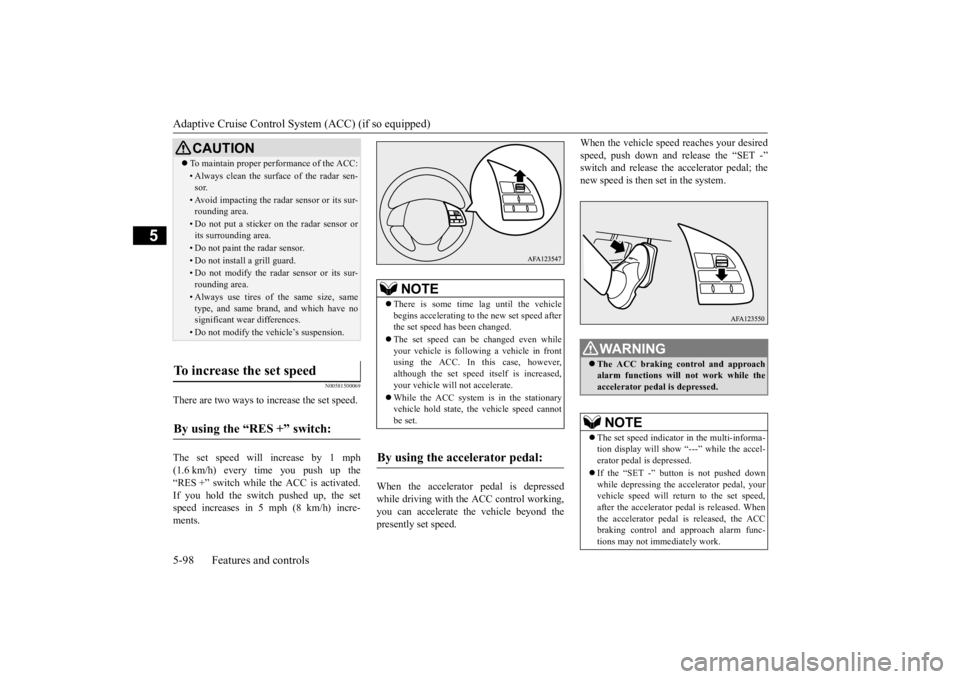
Adaptive Cruise Control System (ACC) (if so equipped) 5-98 Features and controls
5
N00581500069
There are two ways to increase the set speed. The set speed will increase by 1 mph (1.6 km/h) every time you push up the“RES +” switch while the ACC is activated. If you hold the switch pushed up, the set speed increases in 5 mph (8 km/h) incre-ments.
When the accelerator pedal is depressed while driving with the ACC control working,you can accelerate the vehicle beyond the presently set speed.
When the vehicle speed reaches your desired speed, push down and release the “SET -” switch and release the accelerator pedal; the new speed is then set in the system.
CAUTION To maintain proper performance of the ACC:• Always clean the surface of the radar sen- sor.• Avoid impacting the radar sensor or its sur-rounding area.• Do not put a sticker on the radar sensor orits surrounding area.• Do not paint the radar sensor.• Do not install a grill guard.• Do not modify the radar sensor or its sur- rounding area.• Always use tires of the same size, sametype, and same brand, and which have nosignificant wear differences.• Do not modify the vehicle’s suspension.
To increase the set speed
By using the “RES +” switch:
NOTE
There is some time lag until the vehicle begins accelerating to the new set speed after the set speed has been changed. The set speed can be changed even while your vehicle is following a vehicle in frontusing the ACC. In this case, however, although the set speed itself is increased, your vehicle will not accelerate. While the ACC system is in the stationary vehicle hold state, the vehicle speed cannotbe set.
By using the accelerator pedal:
WA R N I N G The ACC braking control and approach alarm functions will not work while the accelerator pedal is depressed.NOTE
The set speed indicator in the multi-informa- tion display will show “---” while the accel- erator pedal is depressed. If the “SET -” button is not pushed down while depressing the accelerator pedal, yourvehicle speed will return to the set speed, after the accelerator pedal is released. When the accelerator pedal is released, the ACCbraking control and approach alarm func- tions may not immediately work.
BK0277700US.bo
ok 98 ページ 2019年3月8日 金曜日 午前9時23分
Page 188 of 427
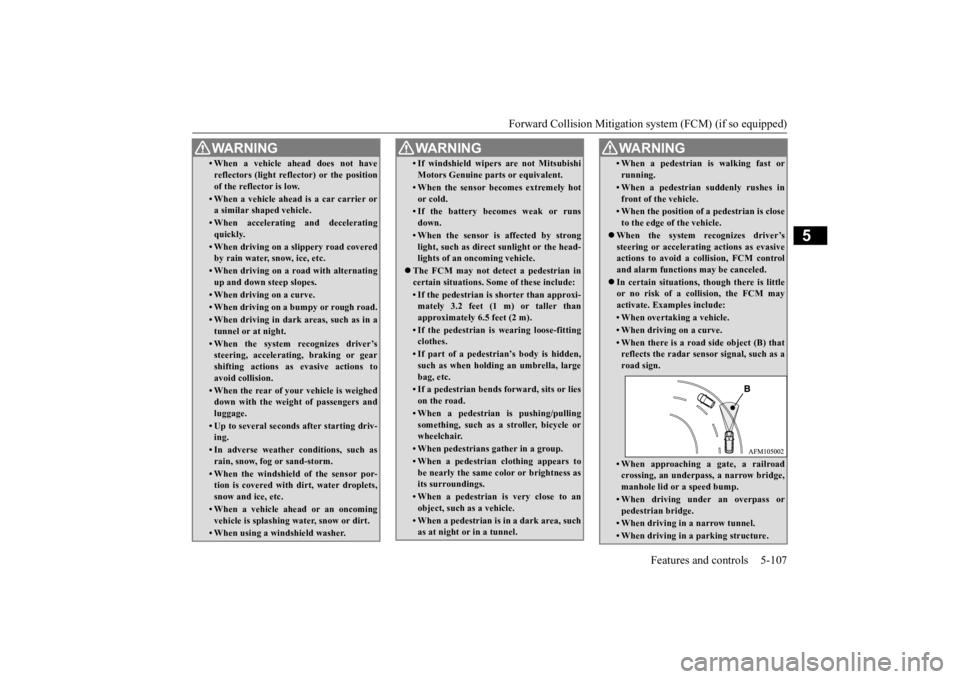
Forward Collision Mitigation sy
stem (FCM) (if so equipped) Features and controls 5-107
5
• When a vehicle ahead does not have reflectors (light reflector) or the position of the reflector is low.• When a vehicle ahead is a car carrier ora similar shaped vehicle.• When accelerating and deceleratingquickly.• When driving on a slippery road coveredby rain water, snow, ice, etc.• When driving on a road with alternatingup and down steep slopes.• When driving on a curve.• When driving on a bumpy or rough road.• When driving in dark areas, such as in a tunnel or at night.• When the system recognizes driver’ssteering, accelerating, braking or gear shifting actions as evasive actions toavoid collision.• When the rear of your vehicle is weigheddown with the weight of passengers and luggage.• Up to several seconds after starting driv-ing.• In adverse weather conditions, such asrain, snow, fog or sand-storm.• When the windshield of the sensor por- tion is covered with dirt, water droplets,snow and ice, etc.• When a vehicle ahead or an oncomingvehicle is splashing water, snow or dirt. • When using a windshield washer.WA R N I N G
• If windshield wipers are not Mitsubishi Motors Genuine parts or equivalent. • When the sensor becomes extremely hot or cold.• If the battery becomes weak or runsdown.• When the sensor is affected by stronglight, such as direct sunlight or the head-lights of an oncoming vehicle.
The FCM may not detect a pedestrian in certain situations. Some of these include:• If the pedestrian is shorter than approxi-mately 3.2 feet (1 m) or taller than approximately 6.5 feet (2 m).• If the pedestrian is wearing loose-fittingclothes.• If part of a pedestrian’s body is hidden,such as when holding an umbrella, large bag, etc.• If a pedestrian bends forward, sits or lieson the road.• When a pedestrian is pushing/pullingsomething, such as a stroller, bicycle orwheelchair.• When pedestrians gather in a group.• When a pedestrian clothing appears tobe nearly the same color or brightness as its surroundings.• When a pedestrian is very close to anobject, such as a vehicle.• When a pedestrian is in a dark area, suchas at night or in a tunnel.WA R N I N G
• When a pedestrian is walking fast orrunning.• When a pedestrian suddenly rushes in front of the vehicle.• When the position of a pedestrian is closeto the edge of the vehicle.
When the system recognizes driver’s steering or accelerating actions as evasiveactions to avoid a collision, FCM control and alarm functions may be canceled. In certain situations, though there is little or no risk of a collision, the FCM may activate. Examples include: • When overtaking a vehicle.• When driving on a curve.• When there is a road side object (B) thatreflects the radar sensor signal, such as a road sign.• When approaching a gate, a railroad crossing, an underpass, a narrow bridge, manhole lid or a speed bump.• When driving under an overpass orpedestrian bridge.• When driving in a narrow tunnel.• When driving in a parking structure.WA R N I N G
BK0277700US.book
107 ページ 2019年3月8日 金曜日 午前9時23分
Page 190 of 427
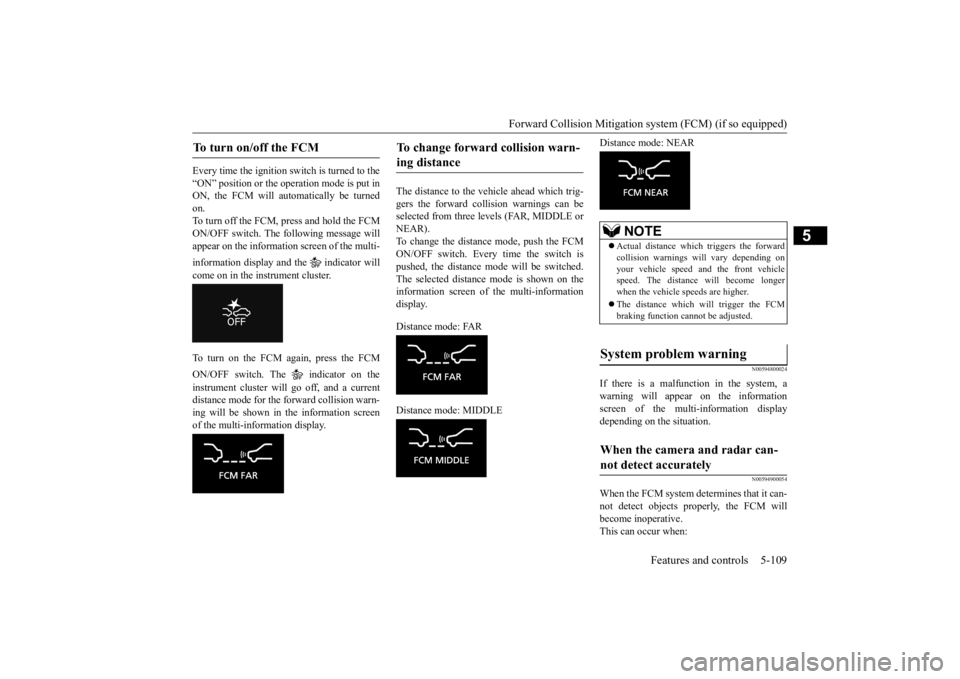
Forward Collision Mitigation sy
stem (FCM) (if so equipped) Features and controls 5-109
5
Every time the ignition switch is turned to the “ON” position or the operation mode is put in ON, the FCM will automatically be turnedon. To turn off the FCM, press and hold the FCM ON/OFF switch. The following message willappear on the information screen of the multi- information display and the indicator will come on in the instrument cluster. To turn on the FCM again, press the FCM ON/OFF switch. The indicator on the instrument cluster will go off, and a current distance mode for the forward collision warn- ing will be shown in the information screenof the multi-information display.
The distance to the vehicle ahead which trig- gers the forward collision warnings can be selected from three levels (FAR, MIDDLE orNEAR). To change the distance mode, push the FCM ON/OFF switch. Every time the switch ispushed, the distance mode will be switched.The selected distance mode is shown on the information screen of the multi-information display. Distance mode: FAR Distance mode: MIDDLE
Distance mode: NEAR
N00594800024
If there is a malfunction in the system, a warning will appear on the information screen of the multi-information displaydepending on the situation.
N00594900054
When the FCM system determines that it can-not detect objects properly, the FCM willbecome inoperative. This can occur when:
To turn on/off the FCM
To change forward collision warn- ing distance
NOTE
Actual distance which triggers the forward collision warnings will vary depending on your vehicle speed and the front vehiclespeed. The distance will become longer when the vehicle speeds are higher. The distance which will trigger the FCM braking function cannot be adjusted.
System problem warning
When the camera and radar can- not detect accurately
BK0277700US.book
109 ページ 2019年3月8日 金曜日 午前9時23分
Page 194 of 427
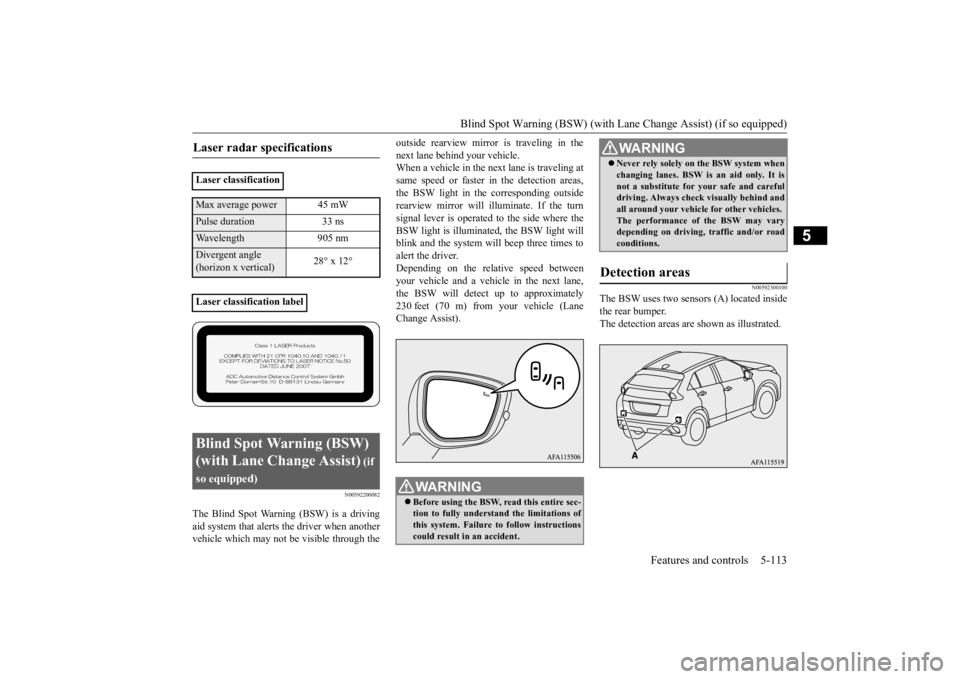
Blind Spot Warning (BSW) (with Lane
Change Assist) (if so equipped) Features and controls 5-113
5
N00592200082
The Blind Spot Warning (BSW) is a driving aid system that alerts
the driver when another
vehicle which may not be visible through the
outside rearview mirror is traveling in the next lane behind your vehicle. When a vehicle in the next lane is traveling at same speed or faster in the detection areas,the BSW light in the corresponding outside rearview mirror will illuminate. If the turn signal lever is operated to the side where theBSW light is illuminated, the BSW light will blink and the system will beep three times to alert the driver.Depending on the relative speed betweenyour vehicle and a vehicle in the next lane, the BSW will detect up to approximately 230 feet (70 m) from your vehicle (LaneChange Assist).
N00592300100
The BSW uses two sensors (A) located insidethe rear bumper.The detection areas are shown as illustrated.
Laser radar specifications
Laser classificationMax average power 45 mWPulse duration 33 nsWavelength 905 nmDivergent angle(horizon x vertical)
28° x 12°
Laser classification labelBlind Spot Warning (BSW) (with Lane Change Assist)
(if
so equipped)
WA R N I N G Before using the BSW, read this entire sec- tion to fully understand the limitations of this system. Failure to follow instructionscould result in an accident.
Never rely solely on the BSW system when changing lanes. BSW is an aid only. It is not a substitute for your safe and careful driving. Always check visually behind and all around your vehicle for other vehicles.The performance of the BSW may vary depending on driving, traffic and/or road conditions.
Detection areas
WA R N I N G
BK0277700US.book
113 ページ 2019年3月8日 金曜日 午前9時23分
Page 195 of 427

Blind Spot Warning (BSW) (with Lane
Change Assist) (if so equipped)
5-114 Features and controls
5
N00593500112
When the ignition switch is turned to the “ON” position or the operation mode is put in
WA R N I N G In certain situations, the BSW may not detect a vehicle in the detection areas orthe detection may be delayed. Some of these include;• When a small motorcycle or a bicycle isbehind your vehicle.• When a vehicle is traveling alongside ofyour vehicle at nearly the same speed for prolonged periods of time.
• When the heights of the next lane and your lane are different.• Immediately after the BSW has been turned on.• Immediately after the ignition switch isturned to the “ON” position or the oper-ation mode is put in ON.• Under adverse weather conditions, suchas rain, snow, strong winds, snow or sand storm.• When your vehicle becomes too close toanother vehicle.• While multiple vehicle are overtakingyour vehicle.• When driving near a pot hole and tram-line.• When a surrounding vehicle or anoncoming vehicle is splashing water, snow or dirt.• When driving on a curve including thebeginning and the end of the curve.• When driving on a road with alternatingup and down steep slopes.• When driving on a bumpy or rough road.• When the rear of your vehicle is weighed down or your vehicle is leaning to the right or left due to the weight of passen- gers and luggage or the improper adjust- ment of tire pressure. • When the bumper surface around theradar sensor is covered with dirt, snowand ice, etc.WA R N I N G
• When a bicycle carrier or accessory is installed to the rear of the vehicle.• When the sensor is extremely hot or cold (while the vehicle is parked for a longperiod of time under a blazing sun or in cold weather).CAUTION To maintain proper performance of the BSW, follow the instructions below.• Always keep the bumper surface around thesensor clean.• Avoid impacting the sensor or its surround-ing area.• Do not put a sticker on the sensor or its sur-rounding bumper surface.• Do not paint the sensor or its surroundingbumper surface.• Do not modify the sensor or its surroundingarea.
If the bumper has experienced an impact, the sensor may have been damaged and the BSWmay not function properly. Have the vehicle inspected at an authorized Mitsubishi Motors dealer.
To operate
WA R N I N G
BK0277700US.book
114 ページ 2019年3月8日 金曜日 午前9時23分
Page 198 of 427

Blind Spot Warning (BSW) (with Lane
Change Assist) (if so equipped) Features and controls 5-117
5
N00592900092
When the warning display appears, the radar sensor cannot detect a vehicle traveling sideby side or an approaching vehicle, because foreign objects, such as dirt, snow or ice, adhere to the bumper surface around the sen-sor. Remove a dirt, freezing or foreign material on the bumper surface around the sensor.When the warning display does not disappear after having cleaned the bumper surface around the sensor, contact an authorizedMitsubishi Motors dealer.When there is a foreign object on the sensor
BK0277700US.book
117 ページ 2019年3月8日 金曜日 午前9時23分